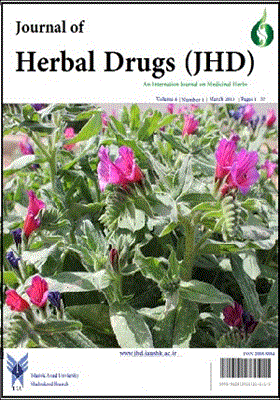-
-
List of Articles
-
Open Access Article
1 - Identification of phytochemicals, plant compounds Smirnovia iranica.
منصوره قوام حسین آذرنیوند مریم اخباری -
Open Access Article
2 - The effect of Kardeh (Biarum Bovei) Hydro-alcoholic extract on pain threshold in STZ induced diabetic rats
معصومه سیفی زنگنه مریم رفیعی راد حسین سازگار -
Open Access Article
3 - بررسی اثر خشک کردن بر استخراج اینولین از کاسنی ریشه ای (Cichuriumintybus L.)
حمیده وکیلی محمد حجت الاسلامی -
Open Access Article
4 - Effect of Hydro-alcoholic Extract of Punica Granatum L. Peel on Ethylene Glycol-Induced Kidney Calculi in Wistar Rats
مصطفی مرتضوی لیلا روحی -
Open Access Article
5 - Evaluation of two methods of manual and mechanized harvesting Echium Amoenum L. and determine the most appropriate method of harvesting
عادل رنجی حمید آقا گل زاده محدثه پورعلی اشکلک محمد مهدی امیری خوریه -
Open Access Article
6 - Dose-dependent effects of Gundelia Tournefortii root extract on meiosis resumption and in vitro maturation in mouse immature oocytes
مرضیه خدابنده لیلا روحی عبدالله قاسمی پیربلوطی -
Open Access Article
7 - Gastroprotective effects of Thymus daenensis hydroalcoholic extract against ethanol-induced gastric mucosal ulcers in rats
فیروزه سقایی محمد صالحی محمد جواد نمازی محمد باقری -
Open Access Article
8 - Variation in yield and yield components in cultivated accessions of Satureja macrantha in Yazd
عباس زارع زاده فاطمه سفیدکن سیدرضا طبایی عقدایی علی میرحسینی محمدرضا عربزاده
-
The rights to this website are owned by the Raimag Press Management System.
Copyright © 2021-2025







